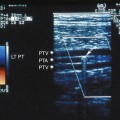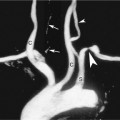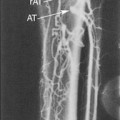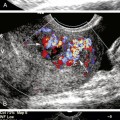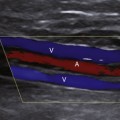20 Risk Factors and the Role of Ultrasound in the Management of Extremity Venous Disease
Acute Venous Thromboembolic Disease
Suspected venous thromboembolic disease (VTE) is the most common reason for the clinical evaluation of the extremity veins. While a comprehensive review of VTE is beyond the scope of this chapter, a brief review of risk factors and conditions fostering the development of VTE is in order. VTE refers to DVT and pulmonary embolism (PE), related aspects of the same disease process. The annual incidence of VTE in the United States is estimated at over 2.5 million cases.1 Roughly 25% of untreated patients with DVT will sustain a nonfatal PE. Moreover, without treatment, PE is associated with a mortality rate of approximately 30%.2 The population at risk represents a myriad of clinical conditions that predispose to venous thrombosis. This susceptibility to develop venous thrombosis was first described in 1865 as Virchow’s triad: venous stasis, endothelial damage, and hypercoagulability.
Antithrombin III deficiency was the first reported congenital thrombotic condition.3 It is transmitted in an autosomal dominant pattern with a prevalence of 1:5000. Isolated spontaneous thrombosis has been described with this condition. Precipitating circumstances, such as trauma, pregnancy, and surgical procedures, seem to lower the threshold for the development of DVT.
Protein C and protein S are vitamin K–dependent cofactors that facilitate degradation of activated factor V. Deficiencies, therefore, predispose to thrombosis. Congenital deficiencies of these factors are well described.4 Since these proteins are synthesized in the liver, acquired deficiencies also may occur from variations in liver function as well as with dietary changes. Protein C or S deficiency confers a roughly sevenfold increased risk for developing venous thrombosis. Resistance to activated protein C is also known as factor V Leiden. This disorder results from a point mutation in the factor V gene, rendering activated factor V resistant to degradation by activated protein C. It is present in 12% to 33% of patients with spontaneous VTE,5 thereby making it the most common inherited hypercoagulable condition.
Factor II (prothrombin) G20210A is a mutation seen in 2% to 3% of individuals, predominantly those of European descent. In a recent study, it was observed to confer a 2.8-fold increase in relative risk for VTE.6
Primary hyperhomocysteinemia increases risk for VTE, along with the development of premature atherosclerosis. Serum elevation of coagulation factors VIII, IX, and XI have been shown to confer elevated risk for venous thrombosis in the Leiden thrombophilia study.7 Factor IX and XI levels greater than the 90th percentile confer a 2.5-fold and 2.2-fold increased risk for VTE, respectively. Dysfibrogenemias and hypofibrinolysis impair the steps involved in the generation, cross-linkage, and breakdown of fibrin. Bleeding diathesis, as well as VTE, has been described with this condition.
Acquired prothrombotic states are more numerous than inherited states. Table 20-1, modified from the Prospective Investigation of Pulmonary Embolism Diagnosis (PIOPED) study,8 shows clinical conditions that predispose to VTE. Several of these conditions are briefly considered. Pregnancy and the postpartum period confer a higher risk for developing VTE than the nonpregnant state. PE is a leading cause of maternal death after childbirth, with 1 fatal PE per 100,000 births.9,10 Oral contraceptives and hormone replacement therapy can increase the risk for VTE in premenopausal and postmenopausal women. Lidegaard and colleagues reported a prevalence of VTE in women receiving oral contraceptives of 1 to 3 in 10,000.11 Women receiving hormone replacement therapy have a twofold increased risk for VTE with rates depending on the type of contraceptive and decreasing with duration of use.11 Antiphospholipid antibody syndrome refers to the presence of either the lupus anticoagulant antibody or anticardiolipin antibodies. Overall, the syndrome can be identified in 1% to 5% of the population. Among those with positive titers for the lupus anticoagulant, the risk for developing VTE is 6% to 8%. Patients with anticardiolipin antibody titers greater than the 95th percentile have a 5.3-fold increased risk for developing VTE.12
TABLE 20-1 Acquired Risk Factors for VTE
| Immobilization |
| Surgery within 3 mo |
| Stroke, paralysis of extremities |
| History of VTE |
| Malignancy |
| Obesity |
| Cigarette smoking |
| Hypertension |
| Oral contraception, hormone replacement therapy |
| Pregnancy and puerperium |
| Secondary hyperhomocysteinemia |
| Antiphospholipid syndrome |
| Congestive heart failure |
| Myeloproliferative disorders |
| Nephrotic syndrome |
| Inflammatory bowel disease |
| Sickle cell anemia |
| Marked leukocytosis in acute leukemia |
| Prior VTE |
VTE, venous thromboembolic disease.
An important consideration for the triage of patients is the application of the Well’s score (see Chapter 23). This clinical instrument is a useful guide in determining the need to perform a diagnostic imaging test, most often venous ultrasound, given an a priori likelihood that the patient has VTE.13
Anticoagulation and Thrombolysis in the Management of Venous Thromboembolic Disease
In the absence of contraindication to anticoagulation, prompt institution of heparin therapy is indicated for patients with either confirmed VTE (through imaging techniques) or among patients in whom a moderate or high clinical suspicion of VTE exists. Either unfractionated or low-molecular-weight heparin is effective. Oral warfarin therapy is instituted once therapeutic heparin anticoagulation has been achieved. Warfarin dosing is guided by measuring the international normalized ratio (INR), a reflection of the inhibition of vitamin K–dependent cofactors. While the target INR will vary, depending on the clinical circumstance, it is important to understand that early elevations in the INR (1 to 3 days after institution of warfarin therapy [with an INR target of 2 to 3]) usually result from inhibition of factor VII because of its short half-life. Effective anticoagulation depends on the depletion of factor II (thrombin) and typically requires about 3 to 4 days of warfarin therapy14 to achieve a stable INR. Therapy with oral warfarin in the absence of heparin anticoagulation should be avoided, as days will pass before anticoagulation is adequate, leaving the patient unprotected against PE. Moreover, warfarin therapy in the absence of heparin anticoagulation may paradoxically intensify hypercoagulability and predispose to recurrent VTE.
Thrombolysis is not commonly used among patients with VTE, but there are situations in which it should be considered. Thrombolysis can be lifesaving for patients in whom massive PE causes hemodynamic instability, but this situation is rare. More commonly, thrombolysis may be useful for patients with extensive iliofemoral venous thrombosis, where the risk for development of the postthrombotic syndrome is high. The prevalence and severity of the postthrombotic syndrome are believed to be decreased if rapid thrombolysis is achieved.15 However, the substantial proportion of patients with contraindications to thrombolysis and the associated increase in major bleeding severely limit the use of thrombolytic therapy.
Acute Deep Venous Thrombosis of Specific Extremity Veins
Calf Vein Thrombosis
Most lower extremity DVTs originate in the deep veins of the calf,17,18 although acute thrombus can form anywhere in the venous system. The soleal sinuses of the calf are thought to be the most common site of origin of DVT.19 Untreated calf vein thrombus can progress into the popliteal and femoral veins in up to 30% of cases,20 whereas this risk is drastically reduced by anticoagulation.21 Once the thrombus propagates into the popliteal or femoral vein, therapeutic anticoagulation is needed to decrease the likelihood of pulmonary embolism. In cases where there is a contraindication to anticoagulation, inferior vena cava placement may be required to prevent PE. However, the clinical importance of isolated calf DVT remains uncertain. Abundant literature has been published, but much of it is contradictory. Although there is no strong consensus over the prevalence of isolated calf DVT, current clinical practice guidelines favor treatment of calf DVT due to its propensity to progress, the underlying risk for PE, and the likelihood of the postthrombotic syndrome.20,22
The prevalence of isolated calf DVT in specific patient groups is difficult to establish, because many studies include mixed patient populations and a variety of diagnostic techniques. For example, a study by Atri and colleagues23 attempted to better separate patient populations by examining an asymptomatic postoperative high-risk group and a symptomatic ambulatory group. In the asymptomatic postoperative group, 20% of patients were found to have isolated calf DVT; in the symptomatic ambulatory group, the prevalence was 30%. These studies indicate that although it is difficult to establish precisely, isolated calf DVT is not uncommon.
Since most DVTs arise in calf veins, calf DVT can obviously propagate to the popliteal vein and more proximally. More important, do all calf DVTs propagate, and can those that do so be identified? The reported frequency of calf DVT propagation varies markedly. In postoperative patients, the reported rate of propagation varies from 6% to 34%.24–26 Unfortunately, it is not possible to identify thrombi that are likely to propagate and distinguish them from those that are not.
Some authors argue that few, if any, significant pulmonary emboli arise from isolated calf DVT27–29 and therefore that anticoagulation is unnecessary in the absence of demonstrable propagation. Other investigators have reported that patients with PE have calf-only thrombi about 5% of the time.30 These studies are limited by the fact that they are not prospective. Meta-analysis of the importance of calf vein thrombosis provides indeterminate results.31
There is no general agreement on the management of isolated calf DVT since no well-controlled, prospective, randomized trial of treatment of patients with isolated calf DVT has been published. The closest studies by design show an advantage to treatment.20,32,33
Recent American College of Chest Physicians’ guidelines recommend anticoagulation for isolated calf vein DVT. The current recommended length of anticoagulation for calf vein DVT is 3 months, although prior guidelines had recommended 6 weeks.22

